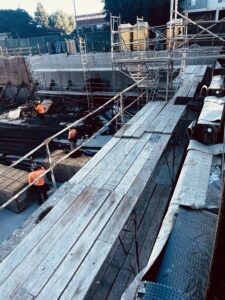Methane is a growing contributor to climate change, the urge to implement methane capture is paramount. Current estimates say methane is 25 times more potent than carbon dioxide over a 100-year period. Methane produces naturally through various processes. Such as human activities, particularly the decomposition of organic waste in landfills, which have rising emissions. However, with the implementation of methane capture techniques, we can turn this environmental challenge into an opportunity for sustainable energy production.
Anaerobic Conditions and Methane Production
The decomposition of organic waste in landfills under goes anaerobic conditions, where oxygen is limited. In this oxygen-deprived environment, microorganisms break down organic matter through a process called anaerobic digestion. As a byproduct of this process, methane then releases into the atmosphere. Without proper management, landfills can become significant sources of methane emissions.
Methane Capture Techniques
To mitigate the environmental impact of methane emissions from landfills, development of various methane capture techniques are growing. These techniques focus on capturing and utilizing the methane produced during anaerobic digestion, thereby reducing its release into the atmosphere.
 Landfill Gas Collection Systems
Landfill Gas Collection Systems
One of the most common methods for methane capture is the installation of landfill gas collection systems. These systems consist of a network of wells and pipes that collect methane as it releases from the landfill. The collected methane is then transported to a central facility for further processing. At the central facility, the process typically purifies to remove impurities such as moisture and other trace gases. Once purified, the methane can be used as a valuable energy source. Methane can combust to generate electricity or heat, or upgraded to natural gas quality for injection into the natural gas grid.
Anaerobic Digestion
Another promising method for methane capture is anaerobic digestion. This process involves the controlled decomposition of organic waste in an oxygen-free environment, similar to that found in landfills. Anaerobic digestion can be implemented on a smaller scale, such as in wastewater treatment plants or agricultural facilities, to trap methane from organic waste streams. Anaerobic digestion not only captures methane but also produces biogas. Biogas is a mixture made of methane and carbon dioxide. Biogas can postulate as a renewable fuel for heating, electricity generation, or vehicle fuel. Additionally, the byproduct of anaerobic digestion is a digestate. This digestate can be useful as a nutrient-rich fertilizer, closing the loop on waste management.
Benefits of Methane Capture
The implementation of methane capture techniques offers several environmental, economic, and social benefits. Environmental benefits from capturing methane, a potent greenhouse gas, methane capture techniques help reduce the overall carbon footprint. It is paramount to understand that methane is a higher global warming risk than carbon dioxide. So its capture and utilization significantly contribute to mitigating climate change
Economic Benefits
Methane capture presents an economic opportunity by turning waste into a valuable resource. The captured methane can be used as a renewable energy source. Thus reduces a reliance on fossil fuels and lowering energy costs. Moreover, the implementation of these systems creates job opportunities in the renewable energy sector. There are health benefits, not only reduces greenhouse gas emissions but also improves air quality by preventing the release of other harmful pollutants associated with landfill gas. This leads to healthier communities and improved quality of life for nearby residents.
Closing Thoughts on Methane Capture
Methane capture techniques offer a sustainable solution to the environmental challenges posed by methane emissions from landfills. By harnessing the power of anaerobic conditions and capturing methane from the decomposition of organic waste, we can significantly reduce greenhouse gas emissions, generate renewable energy, and create economic opportunities. With continued research and investment in methane capture technologies, the future can unlock more potential of anaerobic conditions in landfills and pave the way towards a greener and more sustainable future.
